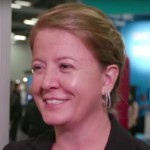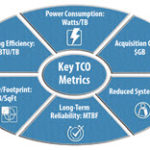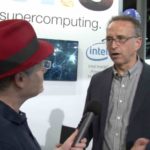Today DDN announced it has increased its leadership as the dominant storage provider of the world’s fastest supercomputers for the eighth consecutive year with storage solutions that power more than 70 percent of identifiable sites on the most recent TOP500 list. To learn more, we caught up with the company’s Chief Marketing Officer, Molly Rector. “We’ve led the TOP500 list for eight consecutive years and continue to increase our leadership margin – most recently boosting our presence to an unprecedented 70% of the identifiable largest supercomputing sites worldwide.”
Archives for June 2016
Intel Furthers Machine Learning Capabilities
“Intel provided a wealth of machine learning announcements following the Intel Xeon Phi processor (formerly known as Knights Landing) announcement at ISC’16. Building upon the various technologies in Intel Scalable System Framework, the machine learning community can expect up to 38% better scaling over GPU-accelerated machine learning and an up to 50x speedup when using 128 Intel Xeon Phi nodes compared to a single Intel Xeon Phi node. The company also announced an up to 30x improvement in inference performance (also known as scoring or prediction) on the Intel Xeon E5 product family due to an optimized Intel Caffe plus Intel Math Kernel Library (Intel® MKL) package.”
SGI to Power 1.9 Petaflop Supercomputer at University of Tokyo
The University of Tokyo has chosen SGI to perform advanced data analysis and simulation within its Information Technology Center. The center is one of Japan’s major research and educational institutions for building, applying, and utilizing large computer systems. The new SGI system will begin operation July 1, 2016. “The SGI integrated supercomputer system for data analysis and simulation will support the needs of scientists in new fields such as genome analysis and deep learning in addition to scientists in traditional areas of computational science,” said Professor Hiroshi Nakamura, director of Information Technology Center, the University of Tokyo. “The new system will further ongoing research and contribute to the development of new academic fields that combine data analysis and computational science.”
Supercomputer Power Management
Today’s HPC supercomputers have significant power requirements that must be considered as part of their Total Cost of Ownership. In addition, efficient power management capabilities are critical to sustained return on investment.
Thomas Sterling presents: HPC Achievement and Impact 2016
Thomas Sterling presented this keynote at ISC 2016 in Frankfurt. “Even as the hundred petaflops era is coming within sight, more dramatic programs to achieve exaflops capacity are now emerging with the expectation of this two orders of magnitude advance in the early part of the next decade. Yet the challenges of the end of Moore’s Law loom ever greater, threatening to impede further progress. Innovations in semiconductor technologies and processor socket architecture matched with application development environments improvements promise to overcome such barriers. This keynote presentation will deliver a rapid-fire summary of the major accomplishments of the last year that promises a renaissance in supercomputing in the immediate future.”
Supercomputing Gravitational Waves at NCSA
“Gravitational wave astrophysics will enter a new phase during the second observing run,” said Eliu Huerta, head of the relativity group at NCSA and leader of the 18-member NCSA LIGO team at Illinois. “Given the detection rate during the first observing run last year, we expect to experience a swift transition from the first detections phase to the astrophysics phase, when we will be able to make strong inferences about the distribution of masses and angular momenta of black holes and neutron stars and possibly detect unexpected events. The work we are doing at NCSA on gravitational wave source modelling and data analysis will provide key insights.”
Supercomputing the Link Between Life and Water
“For a long time, scientists have been trying to figure out how water interacts with proteins. This is a fundamental problem that relates to protein structure, stability, dynamics and—finally—function,” said Zhong, who is the Robert Smith Professor of physics at Ohio State. “We believe we now have strong direct evidence that on ultrafast time scales (picoseconds, or trillionths of a second), water modulates protein fluctuations.”
KAUST Empowers Researchers to Think Big
In this special guest feature, Jane Glasser writes that Saudi Arabia has moved into the global supercomputing top ten with Shaheen II, a 200,000-core behemoth that’s taming global warming, earthquakes, and more. “With 5.536 Pflops of sustained LINPACK performance, Shaheen II is the largest and most powerful supercomputer in the Middle East and the tenth fastest supercomputer in the world, according to the June 2016 TOP500 list.”
For SGI, This is Supercomputing at ISC 2016
In this video from ISC 2016, Gabriel Broner from SGI describes the company’s innovative solutions for high performance computing. “As the trusted leader in high performance computing, SGI helps companies find answers to the world’s biggest challenges. Our commitment to innovation is unwavering and focused on delivering market leading solutions in Technical Computing, Big Data Analytics, and Petascale Storage. Our solutions provide unmatched performance, scalability and efficiency for a broad range of customers.”
Intel Xeon Phi Developer Access Platform at ISC 2016
In this video from ISC 2016, Kirti Devi from Intel describes the new Intel Developer Platform for the Intel Xeon Phi processor. “With this program, Intel and its partner Colfax are widening early levels of access, support and training for the widely anticipated next-generation Intel Xeon Phi processor release. The Developer Access Program gives developers the opportunity to begin leveraging key new capabilities in the processor before they are generally available. That means developers will have time to work to parallelize and vectorize their code and look for opportunities to exploit the massive performance capabilities that KNL offers so workloads are ready for prime time when customers deploy their next-generation systems.”













